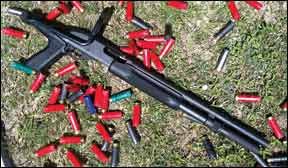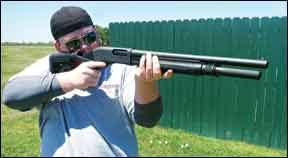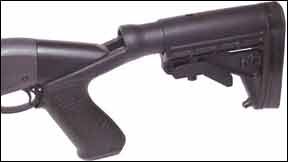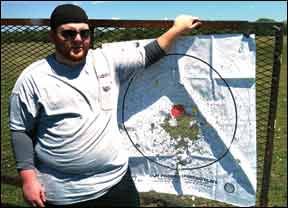The nearly unquestioned champion of home defense is the shotgun, which provides power, capacity, and hall-clearing firepower when youre the only one standing between some zombies and your loved ones. Unlike in concealed carry, where portability is extremely important, the home shotgun can stand magazine-loaded but in a safe condition in a corner, waiting to answer whatever bad news the night brings in on size 13 boots.
Assuredly, the plugged-for-ducks pumpgun can do double duty in this role, offering three shots of No. 4s, but 5 or 7 or 12 handy shots are better, most would agree, so a certain tactical design comes to the fore.

Many consumers love the Remington 870 pump shotgun both as a field product or as a tactical shotgun. We have tested and rated many of them very highly. This round we wanted to take an 870 that had good basic appeal and see if adding some stuff to it would make it better.
Toward that end, we looked back nearly six years and found an 870 that earned a Buy It rating, but which lost ground to the test winner in part because of its stock. In the September 2005 issue, we tested the Remington Model 870 Express Magnum Synthetic 12 gauge No. 25077, $345, against the Mossberg Persuader Model 590A1 No. 51411 and the Winchester Defender Model 1300 Pistol Grip & Stock Combo No. 512907308. All three guns were matte-black synthetic-stock pumps with 3-inch chambers, with 18- to 18.5-inch barrels and weights around 7 pounds. One of our staffers wound up keeping the Model 870 Express Synthetic, but he wasnt happy with the furniture. The fixed 870 buttstock had an LOP of 14 inches, a drop at comb of 1.5 inches, and a drop at heel of 2.5 inches, with no noticeable cast. In the 2005 test, the Winchester came with a pistol grip, which gave it flexibility the others couldnt match. Also, the Winchester had a noticeably better buttpad than the others. Its ventilated design was much softer, and the edges were already rounded off. As well, the Mossberg and Winchester buttstocks included molded-in studs for rear sling swivels, and the Winchester also included a screw-in stud on its magazine cap. Overall, our team said the Winchesters stock was much better than the Remingtons, so that naturally became the area we wanted to try to improve.
So we ordered five replacement buttstock kits from Brownells, along with some tools to make assembling the upgraded 870 parts easier. Because Brownells offers so many buttstocks, weve listed the companys order numbers to ensure you can find the right product if you choose to follow our advice and buy one. Our test units were the Blackhawk Knoxx SpecOps Folding Stock ($130; #100-003-180), the Blackhawk Knoxx SpecOps Adjustable Recoil-Reducing Stock ($135; #100-002-438), the Phoenix Technology KickLite Tactical Stock ($110; #100-005-357), the Brownells Remington 870 Tactical Conversion Kit ($180, #080-000-567); Choates Top-Fold Stock ($103, #159-000-014), and the Mesa Tactical Products Low-Tube Kit ($230, #100-003-297).

Along with these stocks, we also ordered a Brownells Magna-Tip Ratchet Handle ($30, #080-000-513) and a Remington Forend Wrench ($51, #080-870-202). Not to veer too far off course, but its worth noting that our team came to depend on these two tools very heavily while moving the stocks on and off the test action. The ratcheting driver has an ergonomically designed T-shaped handgrip of high-impact plastic contoured to ensure maximum comfort and control. It provided extra leverage to quickly tighten or loosen the stock screws, and it accepts all Magna-Tip bits, which are magnetized. On a couple of the stocks, the magnetism was a godsend in aligning screws in dark, deep pockets and getting them started with a twist of the wrist.
The Remington Forend Wrench made getting to and removing the action nut on the 870 simple, which was helpful on the three kits that had forend replacements. That became doubly important because we compared the forends to each other in administrative handling indoors, and decided to keep the original Remington forend on throughout our shooting tests. Making those “is-A-better-than-B?” forend changes without the forend wrench would have been arduous.
How We Tested
We graded the kits in two major areas: Ease of installation and shooting improvement. Of the two, how the stocks changed the 870s performance at the range was the primary grading point. Our thinking was, even if an installation was difficult, if the feel on the shoulder was right, then wed happily tolerate what would likely be a one-time install. But if the range results came out even, then we would use the ease of installation to break the tie.
So, to start, we stripped the 870 of its OEM buttstock (2 minutes 7 seconds) and installed each kits pieces sequentially, timing the process from opening to completed install. We also included the time needed to read the directions, if it came to that. We found that most of the products were easy to install with a rip and a glance, save for the Mesa Tactical unit. (We should note that the staples in the clamshell boxes cut our fingers more than once, so watch out for them.)
At the range, we used a single shooter to shoot the standard buttstock then compare its performance to all of the replacement products one through five, firing a range of shotshell payloads and powder charges arbitrarily mixed together. Because some of the cartridges were 3-inch magnum shotshells, a sloppy mount or slippery grip would punish the shooter, thereby making his assessment of the stocks design a little less rosy. In theory, this disadvantaged the later competitors because the pounding of mixed-in 3-inch magnum shotshells will take its toll on anyone, but this turned out to be a non-issue, with two of our favorites being shot later in the day.

For each gun, the shooter would start at low ready with the butt pre-seated in the shoulder pocket. He would then mount and dry-fire the gun, making real-time comments about each stock, which were captured on iPhone 4 videos. Once the shooter was satisfied with the handling, a helper would load a selection of rounds for the shooter, who would then take the “hot” gun from low ready, mount and fire a single round, dismount back to low ready, and continue the process until 6+1 shots were fired. Then the shooter would record comments about that stock. He would fire as many shots as necessary to form judgments about cheek weld, sight picture, grip comfort, recoil, buttpad comfort, and slipperiness/mounting quality. Below, the products are graded in these areas in order of testing.
We started with the original stock, noting that it was short for our test shooter. After handling the pistol grips during our installation segment, he said he didnt like the shotgun-style grip because it didnt offer as much control or steering ability. He did like the soft buttpad, but perhaps because of the stock geometry, he said the 870 kicked more with the original stock on the gun.
Mesa Tactical Products Low-Tube Kit, $230
This kit contains a receiver adapter and extension tube made of hardcoat-anodized dark-gray aluminum. Attaching to the rear of the extension tube is the buttstock, made of molded matte-black polymer with a matte-black steel buttplate. Attaching to the bottom of the receiver adapter is a pistol grip with a fiberglass core overmolded with soft rubber. It fits the 12- and 20-gauge Remington 870 shotguns and the Remington 7615 rifle.
The bolt-on replacement stock adds a collapsible M4 carbine stock to the 870. The telescoping five-position buttstock allows length-of-pull adjustment to adapt to body armor and heavy tactical clothing. The aluminum receiver adapter bolts to the rear of receiver with the included mounting hardware and requires no permanent alterations to the gun. The extension tube accepts the included M4 SOPMOD buttstock or any aftermarket stock that fits a mil-spec buffer tube. The length of pull adjusts from 10.5 inches to 13.5 inches. White index numbers corresponding to locking positions are visible through a witness hole in the top of the stock.

Underneath, a Hogue overmolded soft-rubber pistol grip with palm swells and finger grooves bolts solidly to receiver adapter. The Low Tube model, which we tested, has the receiver extension tube positioned to allow use of iron sights or the original shotgun bead.
The mounting hardware and installation instructions come packed in a cardboard box, and we spent 10 minutes reading the directions and checking the components. We initially thought we were missing some parts, but a more focused reading of the instructions showed us that everything was there. The instructions say that the installation would take about 30 minutes, but our aggregated time was 44 minutes.
The most difficult part of the install is following the terminology. Because the major parts arent illustrated, youre left to guess what the components are. An illustrated photo guide would be helpful. So would step-by-step illustrated instructions. Probably the best solution would be a short POV video on the Mesa website.
In brief, the instructions direct the shooter to remove the existing stock, then install the pistol grip on the receiver adapter. Its a little tricky to install a grip nut then thread the 1/4-28 Phillips pan head screw into it, but the ratcheting handle driver helped a lot. We also had some trouble installing one of the flush cups in the adapter because the cup seemed damaged, but we lubed it and drove it flush eventually. The stock adapter screwed in easily and simply, and the stock fit onto the tube just as smoothly. We also needed an AR-15 stock wrench to screw down the locking nut against the claw endplate.
We started with this set at the range because of the complexity of the install. Our test shooter liked the adjustability and firm feel of the stock and grip. The cheekweld and view down the barrel were fine, he said. Magnum rounds made him wish for a rubber buttpad rather than the steel plate in back. Still, recoil wasnt bad.
Our Team Said: The Mesa Tactical Products Low-Tube Kit is a solid stock replacement for the 870. Its install was much more complicated than the others, but thats a minor consideration once you realize the job would only have to be done once. We liked that the receiver adapter has mounting holes on sides which allow for installation of the provided push-button sling swivel. Its substantially more expensive than the others.
Phoenix Technology KickLite
Tactical Stock, $110
This kit includes a glass-reinforced injection-molded nylon replacement buttstock, forend, screw-on shotshell holder, mounting hardware, and instructions. It fits only the Remington 870 12 gauge. Similar kits are available for Mossberg (12- and 20-gauge Models 500, 590, and 835, and the Maverick 88) and Winchester (12- and 20-gauge Models 1200 and 1300). The black buttstock adjusts for LOPs from 11.5 to 15 inches.
Our initial install included screwing on the five-shot shell carrier, but once that was done, it took only 3 minutes 30 seconds to go from a bare action to a ready-to-shoot stock. The front end of the stock fits onto the rear of the action with a supplied screw and Allen wrench. We noted that, initially, the stock didnt fit as snugly as we would have liked, wiggling slightly. We tightened the screw further and snugged it up, but it was tricky to get the correct angle in the pocket where the stock screw was accessible. We also installed the kits tactical forend, noting that it had a deeply grooved, no-slip surface. But during dry handling, we preferred the original Remington forend, so we tested the buttstock alone at the range.
During live firing, our test shooter praised the adjustable six-position AR-style buttstocks rubber buttpad and built-in spring-loaded recoil suppression system. He said it vastly reduced shoulder battering, and the stock pointed well. He also liked the ergonomic plastic pistol grip. It was thinner than the rubber units and was more comfortable for him. He liked the swivel stud in the buttstock, which would accept a swivel and sling for muzzle down carry.
Our Team Said: One of the cheaper units felt great to shoot and was among the easier units to install. We had minor problems getting the stockfit tight, and one of the slots in the shellholder was smaller than the others, meaning we had to force the shell into the slot. Picayune complaints, we think. This is a Best Buy.
Choate Top-Fold Stock, $103
This black unit is made of 4140 steel and Zytel. Its a top folder that weighs 2.1 pounds and has a 13-inch LOP. Our model was for the 12-gauge Remington 870, but there are versions for the Mossberg 500/600 12 gauges as well.
Installing this unit is bingo-bango simple. With the original stock off, the Choate fits snugly onto the action, then the user spins a long Allen wrench to screw the unit onto the gun. Because of the depth of the pocket, we found it was easier to use a magnetized star bit to hold the bolt, then insert the bolt into the action. With a few twists of the Magna-Tip handle in that fashion, we could put this stock on in 25 seconds. Also, we learned if we overtightened the stock screw, we couldnt unfold the stock.
Once it was on the gun, we didnt much like the Choate. The Zytel stock has a steel mounting block that folds at the hinge to provide compact carry and transportation of your shotgun. Folded, it was about 8 inches shorter than the collapsing stocks. That part worked fine, cutting the guns OAL by a quarter. And using just the M16-style pistol grip indexed on the chest or at chest level certainly improves maneuverability in close quarters. In particular, our shooter said the diamond-cut checkering molded into the grip ensured a positive hold. But with anything other than light target loads, our shooter said it was painful to shoot.
To shoot it at full length, the operator depresses a push-button and swings the stock downward, and a rubber-coated buttplate flips into place. We didnt find that the 1-inch pad did much to help tame recoil from magnum shells.
Our Team Said: With the stock folded out, the hand on the pistol grip could ride up and get pinched between the hinge and the receiver. We had trouble getting a solid mount when moving the gun from ready, and when we missed the mount, the Choate kicked us hard. We didnt like to shoot it folded or unfolded. But we recognize that some shooters have a need for this specialized part, and it did function as it was supposed to.
Blackhawk Knoxx SpecOps Adjustable Recoil-
Reducing Stock and Replacement Forend, $135
Our test sample fits only the Remington 870 12 gauge, but theres an 870/20 that fits the 20-gauge pumpgun, and there are Mossberg kits for the 12- and 20-gauge Model 500.
Installing the buttstock was easy. Using the supplied long Allen wrench we screwed the stock onto the gun in 2 minutes 27 seconds. As we noted previously, during our initial run-through of the parts, we installed the replacement forend supplied with this kit, but we preferred the stock 870 forend, so we removed the Knoxx forend. Putting the forend on took about 10 minutes and was easy with the Brownells action nut wrench. (Brownells has an excellent installation video that shows how to put this kit on. When you enter #100-002-438 in the search window at www.Brownells.com, the video link pops up on the right side.)
This drop-in replacement stock uses a spring-loaded recoil-absorption system to reduce felt recoil and muzzle rise, which our shooter said was noticeable, even when shooting magnum loads. We also think that part of that perception of reduced recoil was due to the soft 0.6-inch-thick rubber recoil pad. Our shooter also praised the ergonomic plastic pistol grip with finger grooves, which he said helped improve control for fast follow-up shots.
The black molded-polymer butt weighed just under 2 pounds and had five preset locking positions. The length-of-pull adjustment ranged from 11.25 inches to 15.25 inches. The stock height allowed us to continue using the factory front bead with a solid cheekweld. The buttstock has both a sling swivel stud and a slot for mounting a sling system.
Our Team Said: Recoil reduction was very noticeable, even with magnum loads. We liked the fit and feel of the grip, but not quite as much as the Mesa or Phoenix grips, which turned out to be the difference in their rankings.
Brownells Remington 870
Tactical Conversion Kit, $180
This kit includes a Blackhawk Knoxx SpecOps Adjustable Recoil-Reducing Stock and Replacement Forend, reviewed above, and a Wilson Combat machined-steel two-shot magazine extender (Wilson stock #SGET-RH-2), which comes with a magazine spring and high-visibility chartreuse nylon follower. The Wilson components (#800-720-700) sell for $45 separately at www.Brownells.com, so this kit reflects the $135 price for the Blackhawk stock added to the $45 Wilson components. This kit is listed on the Brownells website as the Standard kit (#080-000-567), but we actually received the Deluxe kit ($290, #080-000-568), which includes an XS ghost ring sight. The XS required drilling and tapping the 870s receiver, which we werent ready to do at this time, so we held the XS sights out for another day, and reviewed the other components as if we had received a Standard kit.
Our Team Said: The testers opinion about the Knoxx SpecOps Adjustable Recoil-Reducing Stock are, of course, the same as the separate stock review above, so we looked at just the Wilson magazine extender parts. We replaced the 870s original extender, magazine spring, and follower and just kept them on the gun throughout the test. The knurled, threaded collar screws onto the end of the mag tube and provides a sling loop on the left side of the extension to accept direct attachment of tactical-style slings without swivels. If we were converting a hunting-type 870 to a tactical gun, we would prefer this kit over the SpecOps Adjustable Recoil-Reducing Stock alone. We also plan to keep the Wilson extender on the gun, replacing the original extender and barrel band.
Blackhawk Knoxx SpecOps Folding Stock, $130
This kit contains a black polycarbonate grip and rubber-coated steel buttstock. Installed, it has a 13.75-inch-long length of pull. The grip is 3.5 inches tall, and it measures 2.9 inches long at its widest point front to back. Its 1.1 inches thick across the widest part of the grip. It fits only the 12-gauge Remington 870, but there are Mossberg units that fits 12- and 20-gauge 500/590/835 models and the Maverick 88.
The folding pistol-grip stock installs onto a bare receiver in only 40 seconds using the supplied Allen hex key. No permanent changes to receiver are required; simply remove the factory buttstock and attach the SpecOps Folder with its captive bolt.
The shotgun can be operated and fired with the stock folded, which we note is appropriate for some home-defense and CQB situations in tight spaces like vehicles, doorways, and hallways. We didnt like shooting the gun with just the grip, however. In fact, in our last string of firing, a hot high-brass non-magnum Fiocchi pheasant load hurt our shooters wrist.
Folded down, the steel-wire buttstock with synthetic rubber coating locks securely in both open and closed positions; simply squeeze the rods toward each other to unlock and change position. A swivel stud on the back of the receiver extension provides a single-point sling attachment.
Our Team Said: We didnt like either of the folding stocks much. The Knoxx folder includes a recoil reduction system, but it still kicked our shooter more than he liked. It is possible that some of that discomfort came because hed fired several hundred rounds already, but thats the luck of the draw.
0511-MESA-TACTICAL-LOW-TUBE-KIT.pdf
0511-PHOENIX-TECHNOLOGY-KICKLITE.pdf
0511-CHOATE-TOP-FOLD-STOCK.pdf
0511-BLACKHAWK-KNOXX-SPECOPS.pdf
0511-BROWNELLS-REMINGTON-870.pdf

























